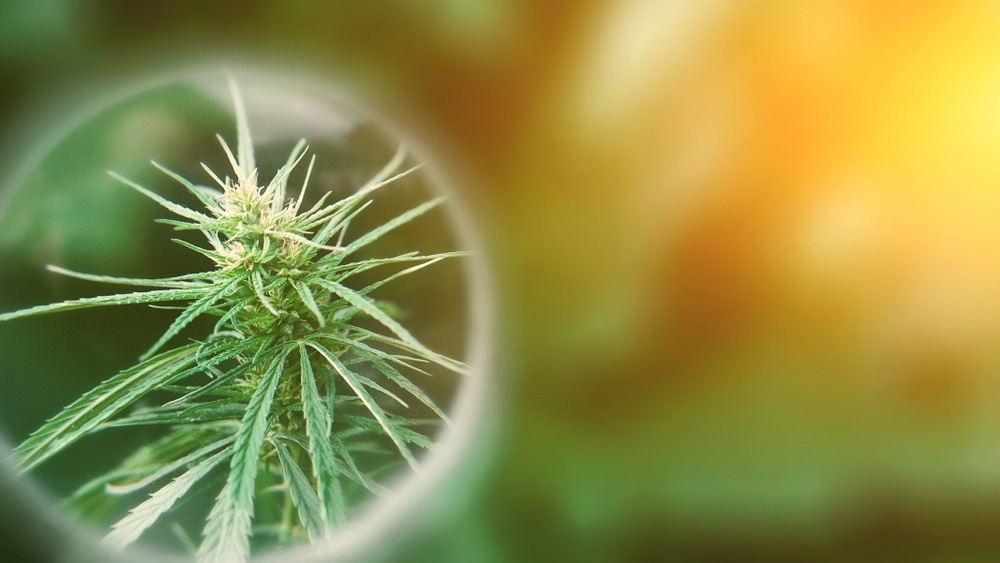Establishing a quick and valuable approach for in situ cannabinoid detection in the hemp plant (Cannabis sativa L.) is an increasing concern in the forensic sector. Among all the approaches for cannabinoid detection, Raman spectroscopy has been selected as the most cost-effective, rapid, non-destructive, and non-invasive technique.

Study: Rapid In Situ Detection of THC and CBD in Cannabis sativa L. by 1064 nm Raman Spectroscopy. Image Credit: PRO Stock Professional/Shutterstock.com
According to a study published in Analytical Chemistry, researchers investigated different cannabis plant samples using Raman spectroscopy with an excitation IR wavelength of 1062 nm.
Using an IR wavelength laser proved the potential to detect cannabinol (CBD) and tetrahydrocannabinol (THC) amounts in fresh samples without additional processing. This eliminated the influence of the fluorescence created by ultraviolet and visible sources.
What are Cannabinoids?
Cannabis sativa L. produces a broad range of items, from food and textile fiber to psychoactive chemicals.
In the 1960s, cannabinoids were categorized as the primary biologically active compounds of cannabis.
Cannabinoid receptor-interacting molecular structures are included in the contemporary concept, focusing more on chemistry and pharmacology.
Cannabis contains more than 60 cannabinoids, most of which are subcategories of cannabidiol (CBD), cannabichromene (CBC), and delta-9- tetrahydrocannabinol (THC).
The Need for Cannabinoid Detection
Three chemotypes of cannabis plants are determined by the THC/CBD ratio.
Drug species (chemotype I) have a ratio greater than 1, whereas intermediate and fiber plants (chemotypes II and III) have a ratio closer to 1 or less.
Compared with THC, a hallucinogenic and frequently illegal narcotic, CBD and CBG are non-psychoactive and contain a wide range of beneficial pharmacological effects. The cannabigerol acid, found in plants in quantities ranging from 25-35% w/w, is the starting material for the biosynthesis of all cannabinoids.
The usage of psychoactive drugs is rising continuously, and a 25% rise has been documented in the past 25 years. For this reason, it is necessary to discover rapid and valuable means of detecting these psychotropic chemicals.
Limitations of Current Techniques Used for Cannabinoid Detection
Many methods are used for cannabinoid detection in cannabis, including gas chromatography (GC), high-performance liquid chromatography (HPLC), mass spectrometers (MS), and flame ionization detectors (FIDs).
Pasteurization of the samples is required for analysis. In most cases, extraction techniques are employed, and the selection of the extraction method is influenced by the precursor material type. There are various current extraction methods and processes for using plant cannabinoids in addition to the conventional methods of maceration, boiling, and distillation. It is important to note that the approaches above are non-portable and generally need lengthy processing periods.
Raman spectroscopy can also be used for cost-effective cannabinoid detection, such as phytocannabinoid characterization. Fluorescence from an excitation wavelength that crosses the Raman signal might be problematic when using such a method. It also necessitates employing a high-power laser for the Raman measurements, which comprises an extraction technique using organic solvents.
Using IR wavelength Raman Spectroscopy for Cannabinoid Detection
The researchers investigated cannabinoid detection using IIR wavelength (1064 nm) Raman spectroscopy. They focused the measurement on the plant's glandular trichomes, which show reddish round bubbles in its inflorescence.
Samples were tested without preliminary treatment of specimens. The uniformity of each sample was checked using confocal microscopy and spectra recorded at several regions.
The multivariate analysis was used to verify the repeatability of the spectra and demonstrate the potential for quickly discriminating the Raman spectra of THC and CBD.
Research Findings
An analysis of 42 samples was carried out using Raman spectroscopy.
An IR wavelength laser unambiguously distinguished THC and CBD in specimens to eliminate the impact of fluorescence from visible and near-IR sources.
The findings allow for the assignment of all Raman characteristics in naturally occurring samples high in THC and CBD.
The multivariate analysis demonstrates the excellent repeatability of the spectra and the ability to differentiate between the two cannabis species' Raman spectra.
A quick test measure for THC concentration in samples is established as the proportion between the Raman spectra at 1295/1440 and 1623/1663 cm-1.
The Potential of Raman Spectroscopy for Cannabinoid Detection
Using Raman spectroscopy with an IR wavelength, researchers demonstrated the enormous potential of the technique for detecting cannabinoids. Raman spectroscopy is a rapid and accurate way to identify illegal goods and evaluate the THC content in fresh plants.
Reference
Porcu, S., Tuveri, E., Palanca, M., Melis, C., La Franca, I. M., Satta, J., Chiriu, D., Carbonaro, C. M., Cortis, P., De Agostini, A., & Ricci, P. C. (2022). Rapid In Situ Detection of THC and CBD in Cannabis sativa L. by 1064 nm Raman Spectroscopy. Analytical Chemistry. https://pubs.acs.org/doi/10.1021/acs.analchem.2c01629
Disclaimer: The views expressed here are those of the author expressed in their private capacity and do not necessarily represent the views of AZoM.com Limited T/A AZoNetwork the owner and operator of this website. This disclaimer forms part of the Terms and conditions of use of this website.